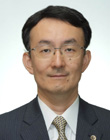Top>People>Teaching at a Law School in the US―――16 Years of Crossing the Ocean and Wearing Two Hats
 Index
Index
Teaching at a Law School in the US
―――16 Years of Crossing the Ocean and Wearing Two Hats
Kozo Yabe
YUASA and HARA
Life as an instructor at the University of Illinois
Every year in December, I receive an email from the University of Illinois College of Law. The email always has a bunch of attachments—all of which contain answers requiring grading. You could call this email an annual Christmas gift from the university, which requires that I complete all of the grading by the end of that year. It is also a very strenuous year-end gift in Japanese custom, particularly considering that I am also extremely busy with my main profession during the end of the year.
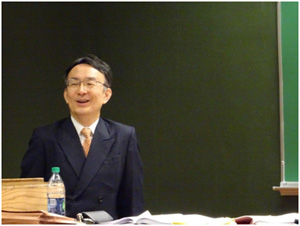
During a lesson
I am a lawyer in Tokyo. My expertise covers intellectual property rights, international corporate transactions, and other fields of corporate law. I also serve as an adjunct professor at the University of Illinois at Urbana-Champaign College of Law. Every year, in the fall semester, I have taught a two-week intensive course “Doing Business in Japan” which features laws concerning business in Japan. The University of Illinois at Urbana-Champaign (U of I) was established in 1867 as a state university of Illinois and is one of the foremost institutions of higher education in the US. It is also well-known as a stronghold of various scientific technologies including IT. 1867 is also the year that Yoshinobu Tokugawa returned power to the Japanese Emperor, that Karl Marx published Capital: Critique of Political Economy and that a patent was granted for dynamite technology, making it around the time of various changes in the late 19th century.
“Doing Business in Japan” is one of the comparative law courses which began at U of I in 1999. Initially, a team of joint instructors was created by three lawyers who are U of I law alumni and are lawyers in Japan. The original course featured an extensive format taught throughout an entire semester in which each instructor gave relay lectures on the area of expertise (corporate acquisitions, real estate investment, international disputes, and intellectual property). I became a member of the team in 2000.
From a budgetary perspective, however, it was difficult for the university to invite three instructors from overseas for a small-group course aimed at upper class students. Therefore, from 2006, the course was reborn as a continuous two-week intensive course. Accordingly, I was placed in charge of the course together with an American lawyer residing in the US. Since then, I have always spent two weeks of the fall semester at U of I, wearing the two hats of instructor during the day and lawyer at night.
Lecture style and condition of students
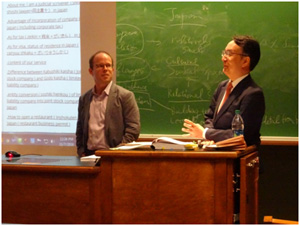
Together with Mr. Glenn Newman

Engaging in discussion with Mr. Newman and students
The course is broadly divided into two weeks. During the first week, I spend every day lecturing on the mechanisms and principles of different fundamental elements of corporate law including the judicial system and legal procedures, contract law, corporate law, antitrust law, labor law, and intellectual property law. During the second week, I am joined by joint instructor, Mr. Glenn Newman as a U.S. admitted lawyer. Together, we introduce two-way cases studies based on actual precedents and judgments in each field of law.
Mr. Newman has experience working at the Tokyo office of an American law firm and overseeing the East Asia region at the legal department of a Silicon Valley corporation. Like myself, he is an alumnus of the U of I College of Law, and he speaks fluent Japanese. Together with this dependable partner, I search the internet for usable educational videos and corporate information. I then analyze these materials in class and hold discussions with my students. My mission is to explain the differences in legal attitudes and concepts between Japan and US by placing focus on corporate behavior.
At first, the course struggled to attract 10 students, but the number of students has continued to increase in recent years. This year, we had a record number of 27 students. These students consisted of 21 students in the Juris Doctor (J.D.) program, 5 students in the Master of Laws (LL.M.) program (including 1 auditing student), and 1 visiting fellow. Furthermore, 17 of the students were Asian-Americans and students from Asian countries (China, South Korea, India, Singapore, Mongolia, and Japan). An increasing number of foreign students from China and South Korea who are proficient in English are enrolling in the J.D. and LL.M. programs. I’m pleased to see those people show an interest in Japanese business law, together with students representing a variety of ethnicities in America.
Teaching this class is a particularly interesting experience for me due to the discussions among people who come from different social backgrounds and speak different native languages. In addition to foreign students from Asia, Europe, and South America, there are also students from countries such as Saudi Arabia and Kenya.
IT technology makes it possible to wear two hats
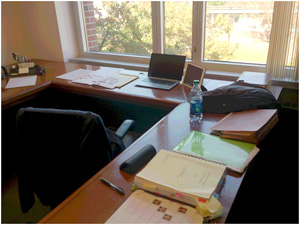
Using laptop and tablet pc at the same time in a professor’s office
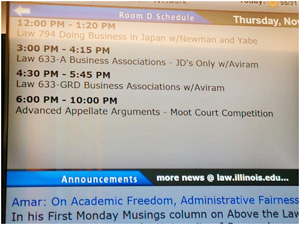
Lecture schedule displayed in front of the classroom
You might think that visiting the US for teaching would mean being free from work responsibilities in Tokyo. However, that is not the case.
Of course, it is difficult to handle work such as courtroom attendance. Nevertheless, thanks to advances in IT technology (email, video conferencing apps, remote access systems, etc.), we have entered an era in which work in Tokyo and all over Japan can be done wherever we are. Wi-Fi access is now available even on an airplane. Through skillful handling of time zone differences, it is possible to handle nearly half a day of work from Tokyo in real-time, even when in the US.
A large number of these IT technologies were born at U of I, a school which has produced numerous Nobel Prize winners and pioneers in the field. In that respect, I am grateful to my alma mater for their achievements. At the same time, I would like to voice some displeasure over how such technologies have made it impossible to get away from my work as a lawyer, no matter where in the world I may go!
Additional benefits of life as an instructor
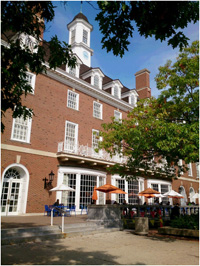
Illini Union (University Headquarters and Student Union Building)
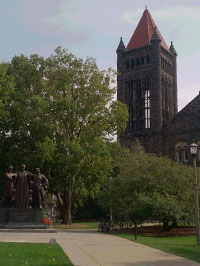
U of I Altgeld Hall (former law school building)
Fortunately, upon entering the 2000s, several outstanding textbooks on Japanese law were published in America. I make copies of these textbooks to use as class material. However, I still have to spend an enormous amount of time every year preparing for the course by reviewing amendments and new judicial precedents. Nonetheless, in addition to updating my own knowledge through such preparation, having the opportunity to instruct American students also helps to cultivate my English-language presentation skills.
As a result, when working at my law firm, I now feel that I am able to give more detailed and accurate explanations of Japanese law and Japanese society to non-Japanese clients. In the same way, when dealing with Japanese clients, I can now better explain legal risk through a comparison with American law. Neither students nor clients are satisfied with a simple explanation of differences between the Japanese and American legal systems. In regards to the questions and intentions of clients, we lawyers are always expected to analyze the reasons for differences in legal systems by considering the essence of said systems, and to give clear and concise explanations for specific ways in which those differences will affect global needs of my clients.
Furthermore, I really look forward to my students graduating and performing outstanding work throughout the world. Some of my students work at foreign law firms in Tokyo, while others work in the international departments of law firms in America. There are also some students who find employment at the US branches of Chinese law firms, and even some students who return to their native country and serve as judges who handle international transaction cases. These are the blessing of being a professor.
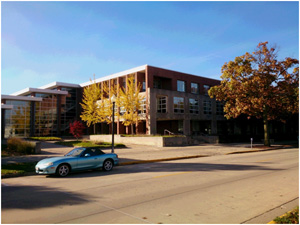
U of I College of Law
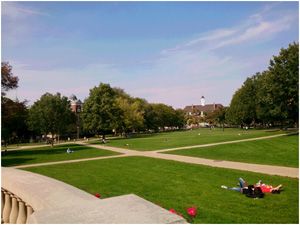
The Quad, a broad square of grass on the U of I campus
Encounter with Chuo University graduates who seek to perform internationally
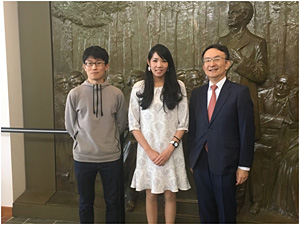
From left: Mr. Fukuuchi, Assistant Judge Imaizumi and the author in front of the memorial replica of the Lincoln-Douglas debates at the U of I College of Law
Moreover, it was a great pleasure to meet Chuo University graduates this year who were performing on a global stage while giving a lecture at the U of I College of Law.
At the U of I College of Law, I met assistant judge Sayaka Imaizumi (a graduate of the Chuo Law School; currently serving as visiting scholar at U of I) and Hiroki Fukuuchi, a member of the legal department at a steel manufacturer (a graduate of the Chuo University Faculty of Law; currently enrolled in the Master’s Program in Law).
I used time off from work to visit Masafumi Masuda, a lawyer who is performing a practical training at a law firm based in Chicago. Masuda was a member of the first graduating class of the intellectual property legal clinic which I taught at the Chuo University Law School. Also joining us was Tomoyuki Watanabe (international business consultant), a member and graduate of the Chuo University Hakkou-kai (Bar Examination Laboratory), who just happened to be in Chicago on a business trip. The three of us savored large steaks in downtown Chicago, at a time when the city was bubbling with excitement at the Chicago Cubs victory in the MLB World Series.
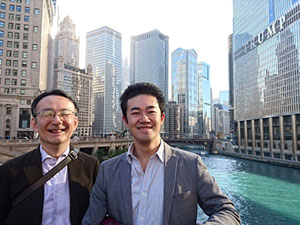
The author and Mr. Masuda on Michigan Avenue Bridge over the Chicago River
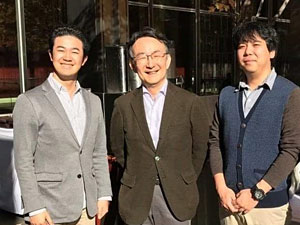
From left, Mr. Masuda, the author, and Mr. Watanabe

Cookies commemorating the Chicago Cubs victory in the MLB World Series

The author and Mr. Kaneko at the U.S.-Japan Council’s meeting in Santa Clara, California
On my way back to Japan, I stopped in Santa Clara, California to participate in the U.S.-Japan Council’s meeting. At the meeting, I was able to meet with Mr. Shinsuke Kaneko, who is also performing a practical training in America. Our meeting was facilitated by Professor Shinichiro Touyama, a former instructor of Kaneko at the Chuo University Law School.
Through these chance encounters, I was able to meet with Chuo University graduates who are pushing forward with the goal of making their mark internationally. I look forward to their further performance in the future.
- Kozo Yabe
YUASA and HARA -
Born in Tokyo.
Graduated from Toin Gakuen High School in 1980 and earned LL.B. from Chuo University Faculty of Law in 1985.
Passed the bar examination in 1988.
Admitted to the Japan Bar in 1991 (Daiichi Tokyo Bar Association).
Earned Master of Laws (LL.M.) from the U of I College of Law in 1994.
From 2005 to 2009, he served as a visiting lecturer at the Chuo Law School.
Currently, he is a partner (lawyer and patent attorney) at YUASA and HARA. Also, he holds positions including Senior Director at the International Association for the Protection of Intellectual Property of Japan (AIPPI Japan), Board Member at the Japan Trademark Association, Director (in charge of International Team) at the IP Lawyers Network Japan, and Vice-Chair at the Law School Center of the Japan Federation of Bar Associations.
- Research Activities as a Member of Research Fellowship for Young Scientists (DC1), Japan Society for the Promotion of Science (JSPS) Shuma Tsurumi
- Important Factors for Innovation in Payment Services Nobuhiko Sugiura
- Beyond the Concepts of Fellow Citizens and Foreigners— To Achieve SDGs Goal 10 “Reduce Inequality Within and Among Countries” Rika Lee
- Diary of Struggles in Cambodia Fumie Fukuoka
- How Can We Measure Learning Ability?
—Analysis of a Competency Self-Assessment Questionnaire— Yu Saito / Yoko Neha - The Making of the Movie Kirakira Megane








